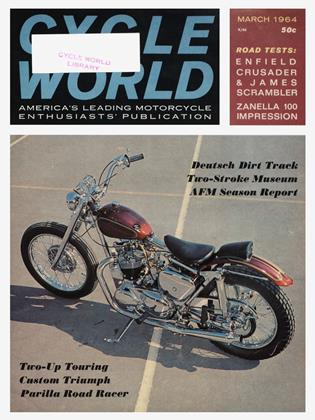THE CANADIAN SCENE
EVE WHITE
ONE OF THE MOST POPULAR forms of motorcycling sport during the winter and spring months is the reliability trial. Its popularity stems partly from the fact that it is comparatively easy to prepare a course, and partly from the fact that almost any age machine or rider can compete.
In Ontario, good trials ground close to a city is at a premium, and most clubs have a favorite spot which is used over and over again, but which is generally not encroached upon by other clubs. Despite the frequent use of the ground, sections are always varied, as the differences in weather play a big part in the make-up of the trial.
In the spring, for instance, the mud sections come into their own as the rivers and streams are often too deep when the thaw comes. In the fall, river and rocky sections are very popular and give the riders a good test of riding skill.
For those who may be new to trials, the organizing club lays out a group of sections, which will be difficult to ride and which give a good variety of testing. Uphill sections, ones with sharp turns, adverse cambers, rocks, loose sand or mud, water and even slippery tree roots will give the riders differing tests of their skill. Putting a foot down or stopping the forward motion of the machine scores points, and the lowest scorer is the winner. In Canada the point system is from 1 to 3 points for “footing” and 5 points for a “failure.” The beginning and ending of the section is marked with a board, and if the route between the start and finish board is not obvious, then other markers, such as large stones, tapes or branches of trees can be used to make the section clear.
For most of our trials we have eight different sections, which are ridden
eight times each, from one to eight each time, and the riders following each other in order of entry. Observers keep the score, one for each section, and when the trial is over, the total scores are computed.
Awards vary a little according to the organizing club, but all have a premier award for the best performance, and many have a team award for the best three-man team. A novice award is given in most trials, and some have a standard tire award for the best performance with other than competition tires. Most clubs also have a best “other class” trophy which is won by the next best rider to the top man. but in a different engine class. For instance. if the winner is riding a 200cc machine, the best other might be a 350cc or 50()cc motorcycle. Scooters are included as a separate class, and many younger riders are being brought into the sport in this way.
Many riders have become very skillful through years of riding, and are able to surmount almost impossible looking sections, but it is well to have in mind the class of rider expected, so that you won't scare off the beginners by making things too tough at first.
The star trials riders in Ontario are Bill Sharpless, John de Gruchy and Dave Daniel, while Quebec has Gordon Raza, Gerald Marshall and Paul Noiseux. B.C. does not seem to have many trials, possibly because their finer and warmer weather makes it possible for them to continue road racing and scrambling for a much longer season than we in the east. Rudy Zacsko figures frequently in Alberta listings. These riders have all reached expert status by constant practice, and there was a time when they were just as “rabbity” as I would be if I had the nerve to try a trial. •
 View Full Issue
View Full Issue










